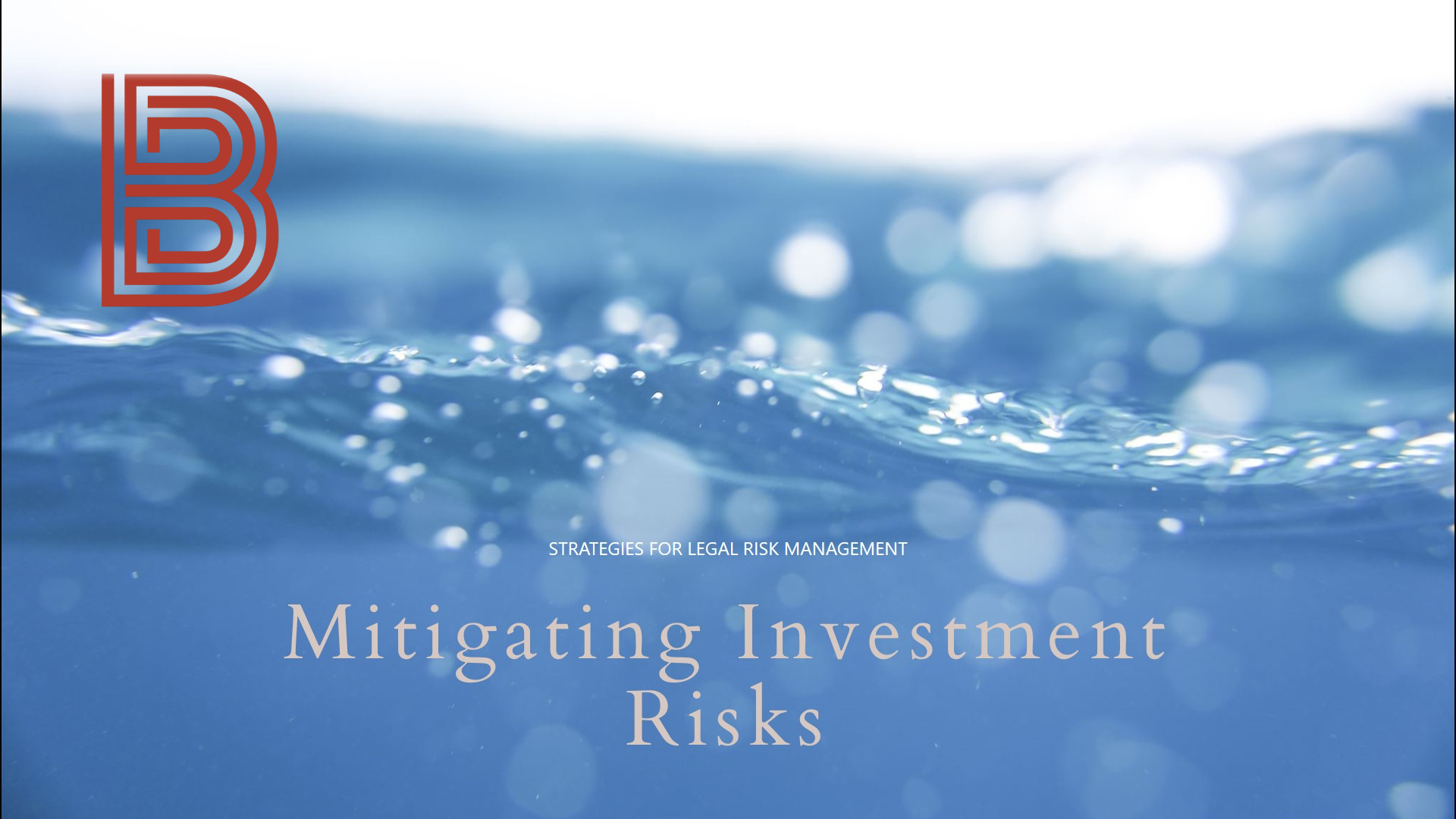
Introduction
Investment activities are fraught with numerous risks, one of the most critical being legal risk. Legal risk refers to the possibility of financial or reputational loss due to legal and regulatory issues, such as non-compliance, contract disputes, liability claims, or changes in legislation. Effective legal risk management is essential for investors to safeguard their investments, ensure compliance with regulatory frameworks, and mitigate the consequences of legal disputes.
This document explores legal risk management in investment, covering key risk factors, regulatory considerations, contractual safeguards, and strategies for mitigating legal exposure.
Understanding Legal Risk in Investment
Legal risk in investment can arise from multiple sources, including:
Regulatory Compliance Risks: Failure to comply with financial regulations and investment laws.
Contractual Risks: Issues arising from poorly drafted agreements or breach of contract.
Litigation Risks: Legal disputes leading to costly lawsuits.
Liability Risks: Investors being held accountable for legal violations.
Fraud and Misrepresentation Risks: Deceptive investment practices leading to legal consequences.
Jurisdictional Risks: Cross-border investments facing differing legal frameworks and enforcement challenges.
Key Legal Risks in Investment
1. Regulatory Compliance Risk
Investors must comply with financial regulations that govern investment activities. These regulations vary by jurisdiction and investment type. Common compliance risks include:
Securities Regulations: Laws governing securities offerings, insider trading, and disclosure requirements.
Anti-Money Laundering (AML) Laws: Regulations preventing illicit financial activities.
Taxation Laws: Compliance with national and international tax laws.
Environmental, Social, and Governance (ESG) Regulations: Requirements related to sustainable and ethical investing.
Data Protection Laws: Regulations such as the GDPR impacting investment activities involving personal data.
2. Contractual Risk
Contractual risk arises when investment agreements are ambiguous, unenforceable, or improperly structured. This includes:
Ambiguous Terms: Poorly defined terms leading to disputes.
Breach of Contract: One party failing to meet contractual obligations.
Indemnification Clauses: Inadequate indemnity provisions exposing investors to unexpected liabilities.
Exit Strategies: Lack of clear exit mechanisms in investment agreements.
3. Litigation Risk
Investment activities can result in litigation due to disputes with counterparties, regulatory investigations, or investor claims. Litigation risks include:
Shareholder Lawsuits: Investors suing companies for misrepresentation or fraud.
Contractual Disputes: Legal battles over contract enforcement.
Employment-Related Lawsuits: Issues arising from labor laws in investment firms.
Regulatory Investigations: Authorities scrutinizing investment practices.
4. Liability Risk
Investors, particularly institutional investors and fund managers, may face liability for negligence, mismanagement, or regulatory breaches. Common liability risks include:
Fiduciary Duty Breaches: Violating duties owed to clients or stakeholders.
Directors and Officers (D&O) Liability: Legal action against company executives for investment decisions.
Market Manipulation and Insider Trading: Legal consequences for fraudulent investment practices.
5. Fraud and Misrepresentation
Investment fraud is a significant legal risk, including:
Ponzi Schemes: Fraudulent investment schemes promising high returns.
Misrepresentation of Financial Statements: Providing false or misleading information.
Bribery and Corruption: Illegal payments to influence investment decisions.
Cyber Fraud: Hacking and financial fraud affecting investment portfolios.
6. Jurisdictional Risk
International investments face legal risks due to differing regulations, including:
Cross-Border Taxation Issues: Unclear tax obligations in multiple jurisdictions.
Expropriation and Nationalization: Governments seizing private investments.
Dispute Resolution Challenges: Enforcing contracts in foreign jurisdictions.
Regulatory Divergence: Differing compliance requirements across borders.
Legal Risk Management Strategies
To mitigate legal risks, investors must adopt comprehensive legal risk management strategies:
1. Regulatory Compliance Framework
Investors should establish a compliance framework to adhere to regulatory requirements:
Legal Counsel and Compliance Officers: Hiring experts to oversee compliance.
Regulatory Monitoring: Keeping abreast of changes in investment laws.
Internal Audits and Controls: Conducting regular compliance audits.
Compliance Training: Educating employees on legal and regulatory requirements.
2. Contractual Safeguards
Investors must ensure that contracts are legally sound and enforceable:
Clear Contract Terms: Defining rights, obligations, and dispute resolution mechanisms.
Due Diligence: Conducting thorough legal review before signing agreements.
Indemnification Provisions: Protecting investors from unforeseen liabilities.
Exit Clauses: Providing mechanisms for withdrawal from investments.
3. Litigation Prevention and Dispute Resolution
To avoid costly litigation, investors should adopt proactive measures:
Alternative Dispute Resolution (ADR): Using mediation and arbitration instead of litigation.
Legal Risk Insurance: Protecting against litigation costs.
Documentation and Record-Keeping: Maintaining accurate investment records.
4. Liability Risk Mitigation
Investors can reduce liability exposure through:
D&O Insurance: Covering directors and officers from personal liability.
Fiduciary Duty Training: Educating managers on ethical investment practices.
Strong Governance Structures: Ensuring transparent investment decision-making.
5. Fraud Prevention Measures
To mitigate fraud risks, investors should:
Enhanced Due Diligence (EDD): Conducting in-depth background checks.
Whistleblower Programs: Encouraging reporting of fraudulent activities.
Cybersecurity Measures: Protecting investment data from cyber threats.
Third-Party Audits: Verifying financial statements for accuracy.
6. Managing Jurisdictional Risks
For cross-border investments, investors should:
Understand Local Laws: Researching foreign investment regulations.
Use Local Legal Advisors: Engaging experts in foreign jurisdictions.
Arbitration Clauses: Including arbitration provisions in contracts.
Diversification: Spreading investments across multiple jurisdictions.
Case Studies
1. Enron Scandal (2001)
Enron’s fraudulent accounting practices led to regulatory changes such as the Sarbanes-Oxley Act, emphasizing corporate governance and legal risk management in investments.
2. Lehman Brothers Collapse (2008)
The collapse of Lehman Brothers highlighted the importance of regulatory compliance and risk management in financial institutions.
3. Volkswagen Emissions Scandal (2015)
Volkswagen’s legal troubles due to environmental violations reinforced the need for ESG compliance in investment decisions.
Summary
Legal risk management in investment is essential for ensuring compliance, preventing disputes, and safeguarding assets. Investors must adopt robust legal frameworks, conduct thorough due diligence, and remain vigilant about regulatory changes. By implementing strategic legal risk management practices, investors can mitigate potential liabilities and protect their financial interests in an increasingly complex global investment landscape.




















